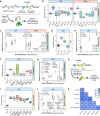This is a preprint.
Small DNA elements that act as both insulators and silencers in plants
- PMID: 39345455
- PMCID: PMC11429706
- DOI: 10.1101/2024.09.13.612883
Small DNA elements that act as both insulators and silencers in plants
Update in
-
Small DNA elements can act as both insulators and silencers in plants.Plant Cell. 2025 Jun 4;37(6):koaf084. doi: 10.1093/plcell/koaf084. Plant Cell. 2025. PMID: 40485594 Free PMC article.
Abstract
Insulators are cis-regulatory elements that separate transcriptional units, whereas silencers are elements that repress transcription regardless of their position. In plants, these elements remain largely uncharacterized. Here, we use the massively parallel reporter assay Plant STARR-seq with short fragments of eight large insulators to identify more than 100 fragments that block enhancer activity. The short fragments can be combined to generate more powerful insulators that abolish the capacity of the strong viral 35S enhancer to activate the 35S minimal promoter. Unexpectedly, when tested upstream of weak enhancers, these fragments act as silencers and repress transcription. Thus, these elements are capable of both insulating or repressing transcription dependent upon regulatory context. We validate our findings in stable transgenic Arabidopsis, maize, and rice plants. The short elements identified here should be useful building blocks for plant biotechnology efforts.
Conflict of interest statement
Competing interests T.J., J.T.C., and C.Q. have filed a patent application related to this work through the University of Washington. The remaining authors declare no competing interests.
Figures











Similar articles
-
Small DNA elements can act as both insulators and silencers in plants.Plant Cell. 2025 Jun 4;37(6):koaf084. doi: 10.1093/plcell/koaf084. Plant Cell. 2025. PMID: 40485594 Free PMC article.
-
Information content differentiates enhancers from silencers in mouse photoreceptors.Elife. 2021 Sep 6;10:e67403. doi: 10.7554/eLife.67403. Elife. 2021. PMID: 34486522 Free PMC article.
-
Computational Analysis of Maize Enhancer Regulatory Elements Using ATAC-STARR-seq.bioRxiv [Preprint]. 2023 Jan 21:2023.01.20.524917. doi: 10.1101/2023.01.20.524917. bioRxiv. 2023. PMID: 36711646 Free PMC article. Preprint.
-
Regulatory regions in DNA: promoters, enhancers, silencers, and insulators.Methods Mol Biol. 2010;674:33-42. doi: 10.1007/978-1-60761-854-6_3. Methods Mol Biol. 2010. PMID: 20827584 Review.
-
STARR-seq - principles and applications.Genomics. 2015 Sep;106(3):145-150. doi: 10.1016/j.ygeno.2015.06.001. Epub 2015 Jun 11. Genomics. 2015. PMID: 26072434 Review.
References
-
- Weising K., Kahl G. Towards an Understanding of Plant Gene Regulation: The Action of Nuclear Factors. Z. Für Naturforschung C 46, 1–11 (1991). - PubMed
Publication types
Grants and funding
LinkOut - more resources
Full Text Sources
